Guide to electronic public procurement system in Ukraine
1. Opportunities for foreign organizations to participate in tenders
Participation in tenders at the expense of donor organizations
Today, many donor organizations and countries provide assistance to Ukraine both as grants and as assistance for the implementation of various projects. Major such organizations and countries today are EBRD, EIB, IBRD, IFC, KFW, EFSE, USAID, MIGA, GGF, FIIAPP, GIZ, Germany, European Union, DFC, BGK, Denmark, UNDP, UNIDO, Switzerland, Sweden, Jica. But there are many other organizations that provide assistance to Ukraine.
Grant assistance is provided on the terms of grant competitions. Most of these competitions are aimed specifically at Ukrainian enterprises and are aimed at research, restoration of damaged enterprises, improvement of their competitiveness and scaling.
Most of the funds for the implementation of state projects, related to addressing social, environmental and economic issues, are spent through competitive procurement procedures (tenders). Tenders are held for the purchase of goods, works and services from various sectors of the economy, such as construction, energy, healthcare, education, etc.
Each organization, the manager of the funds, independently determines the rules (procedures) according to which tenders are carried out and the requirements for participants. Announcements for such purchases are published by organizations on the following resources:
- Own information resources of these organizations
- USAID Competitive Economy Program (CEP) Application Manager (submittable.com)
- Development Projects: Fifth Additional Financing for Public Expenditures for Administrative Capacity Endurance (PEACE) in UKRAINE — P181141 (worldbank.org)
- Procurement | East Europe Foundation (eef.org.ua)
- Funding & tenders (europa.eu)
- eTendering — Search for call for tenders (europa.eu)
- Home | Prozorro
- Free consultations for entrepreneurs (diia.gov.ua)
- https://www.prostir.ua/>
In the announcements of the procurement, the organizers of the tender, as a rule, indicate the following information:
- Description of the procurement procedure;
- Description of qualification requirements for procurement participants (requirements for the availability of personnel with appropriate qualifications, experience, experience of the organization to implement similar contracts, availability of material and technical base (in case of procurement of the works);
- Criteria for evaluating bidders;
- Description of the terms of reference (what exactly needs to be done by the winning participant);
- Draft contract;
- Payment terms;
- Deadlines for submitting requests for clarification of tender requirements;
- Bid submission deadline and bidding;
- Deadline for evaluation and determination of the winner of the bidding;
- Other important information.
Qualification requirements for the participants in each tender are different and depend on the subject of procurement. As a rule, if the tender organizer (customer) procures development services (e.g., development strategy, business plans), it requires participants to have the appropriate education of its specialists, who will be involved in the provision of relevant services, experience in implementing similar projects in the organization and relevant confirmations (the diplomas, the certificates, the copies of the contracts, the feedback from the former clients). There is no standard set of qualification requirements, it depends on the subject of procurement and the requirements of the tender organizer.
When procuring goods, the requirements of the tender organizer depend on the goods being procured and cannot be universal. The tender organizer may require bidders to provide the documents confirming the origin of the goods, the certificates of quality and conformity, the licenses (if required), the technical specifications of the goods, operating and maintenance instructions, information on the warranty obligation and terms of after-sale service. The list of the documents, of course, can be supplemented or reduced depending on the subject of procurement
It is very important to provide all the documents required by the tender organizers because they will be evaluated according to the evaluation criteria and methodology, specified by the tender arranger in its tender announcement. Given this, before making a decision on participation in the procurement, it is necessary to:
- Carefully read all the requirements of the tender organizer;
- Assess the company's compliance with the established qualification requirements;
- Assess the company's ability to provide the services (supply the goods) in the established volumes (quantity and quality) and within the deadline.
2. General information on procurement in the Prozorro system
All procurements at the expense of the state budget of Ukraine and some donor organizations take place in the Prozorro system. Procurement at the expense of international donor organizations can be announced in the Prozorro system (e.g., GIZ, USAID), but the organizer can independently determine the terms and conditions for the tenders. The procurement of goods, works and services for state funds is regulated by the following regulatory documents:
- Law of Ukraine “On Public Procurement dated 25.12.2015 No. 922-VIII”
- Resolution of the Cabinet of Ministers of Ukraine (CMU) on approval of features of public procurement of goods, works and services for customers provided for by the Law of Ukraine “On Public Procurement” for the period of the legal regime of martial law in Ukraine and within 90 days from the date of its termination or cancellation dated 12.10.2022 No. 1178 .
The Prozorro system is an electronic public procurement system where the tender organizers announce the tenders for the purchase of goods, works and services, and businesses participate in these procurements. Currently, all Ukrainian enterprises that are owned by the state or have a state share are required to carry out all their purchases, the amount of which is approximately equal to or exceeds EUR 5 000, through electronic procurement procedures in the Prozorro system.
Architecturally, Prozorro consists of a central database containing information on all public procurement in Ukraine and AEP, authorized electronic platforms, that have received accreditation for the right to provide electronic bidding services. AEP via API (Application Programming Interface) communicates with the Prozorro CDB.
This means that when the bidders submit their bids through the electronic platform, this information is transmitted to the central Prozorro database. You can also get access to the tender data published in the Prozorro system through AEP, which allows you to ensure transparency and openness of the tender procedures.
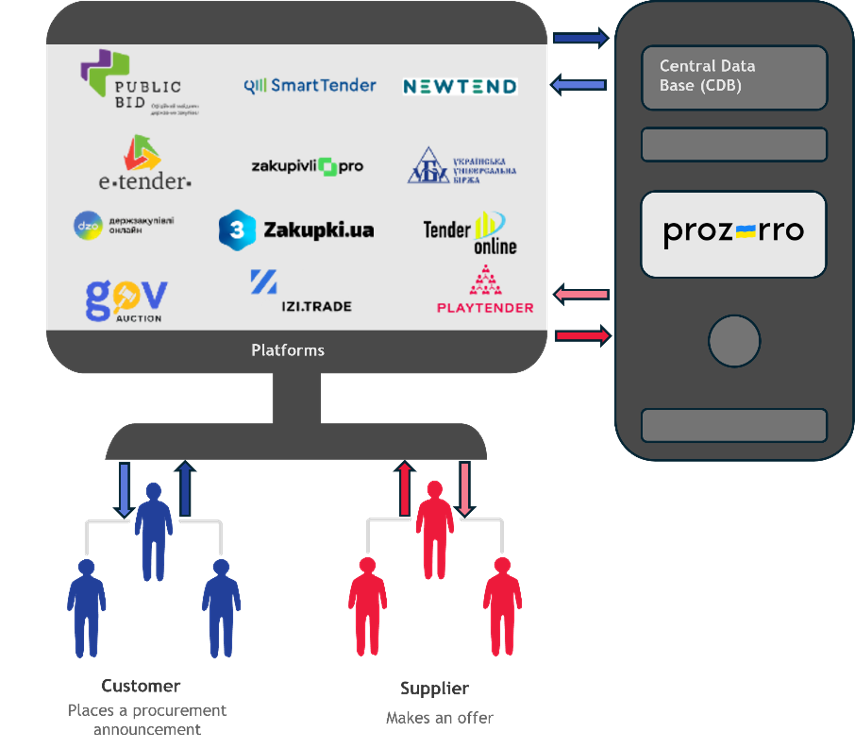
Currently, 12 AEP are accredited in Ukraine. Information about them can be found at the link Home | Prozorro.
To announce the procurement, the tender organizer chooses any platform, but information on this procurement is transmitted to all accredited platforms. The participant, in turn, also chooses any platform where he submits his proposal.
Every day, more than 1000 purchases are published in the system, because the state buys almost everything, from building materials to food, petroleum products, fuel, electricity and much more. The information is publicly available, so anyone can see information about the organizers, the announced tenders, the bidders, the bidding results, and other data.
Currently, the following basic procurement procedures are used in the Prozorro system:
- Open bidding with features is the most common type of the procurement. Any bidder, who meets the requirements of the tender organizer, can participate in them. The winner is the bidder who offered the lowest price, provided that his tender proposal meets all the requirements of the tender documentation.
- Simplified procurement is a type of procurement that is used for the procurement of goods, works or services with a value of up to UAH 200 thousand. Any bidder, who meets the requirements of the tender organizer, can participate in it. The winner is the bidder who offered the lowest price.
Cost limits of procurement procedures:
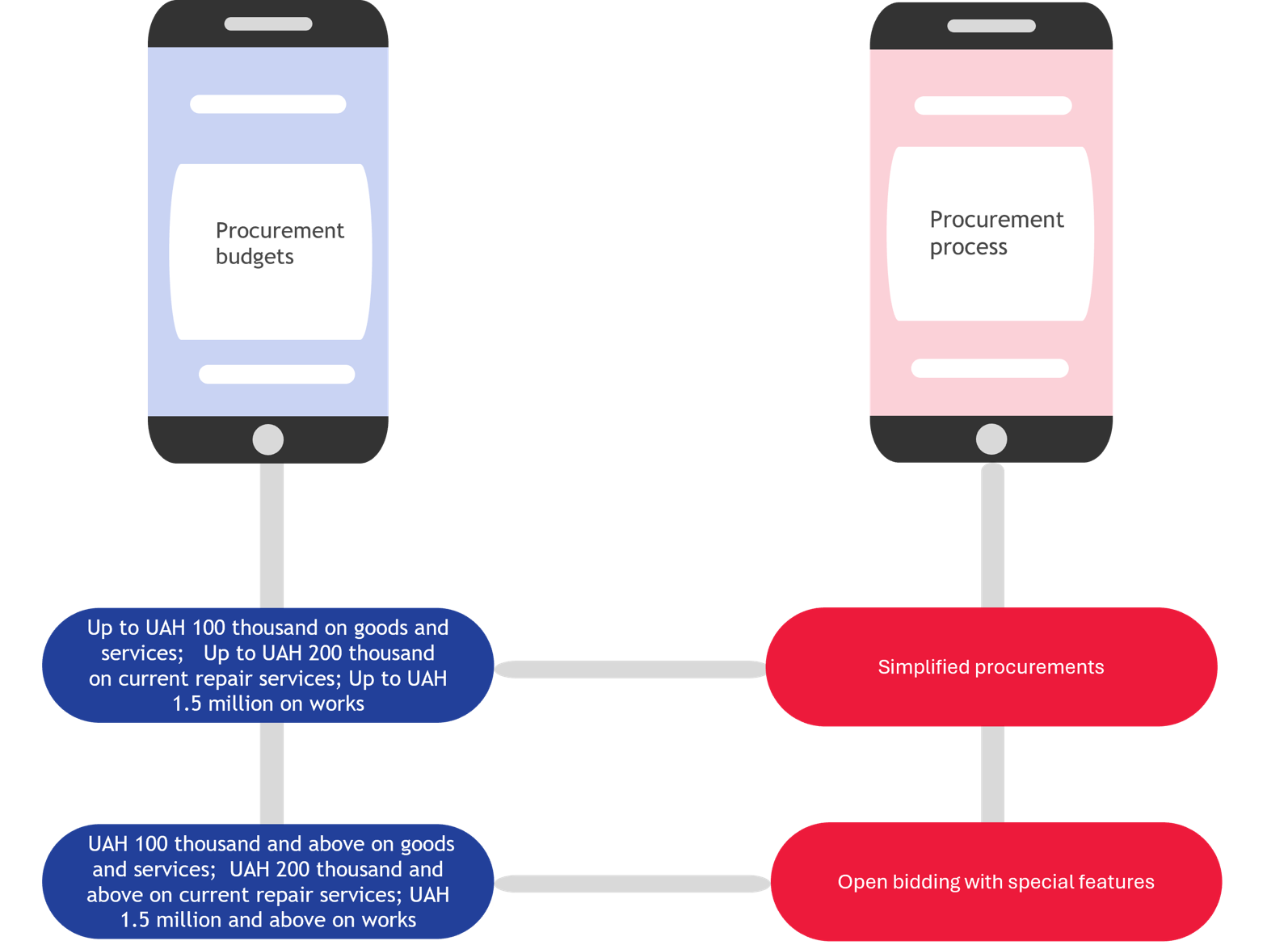
Procedures “Open Bidding with Features”
Open bidding can take place if even 1 participant submits a proposal. That is, if 1 participant submits a tender offer for the purchase, then the procurement immediately goes to the period of consideration of the submitted proposals (without an auction).
Generally, the open bidding procedure with features can be divided into 4 stages:
The main stages of open bidding with Features
- announcement of procurement and submission of proposals,
- auction,
- consideration of proposals (qualification),
- selection of the winner and conclusion of the contract.
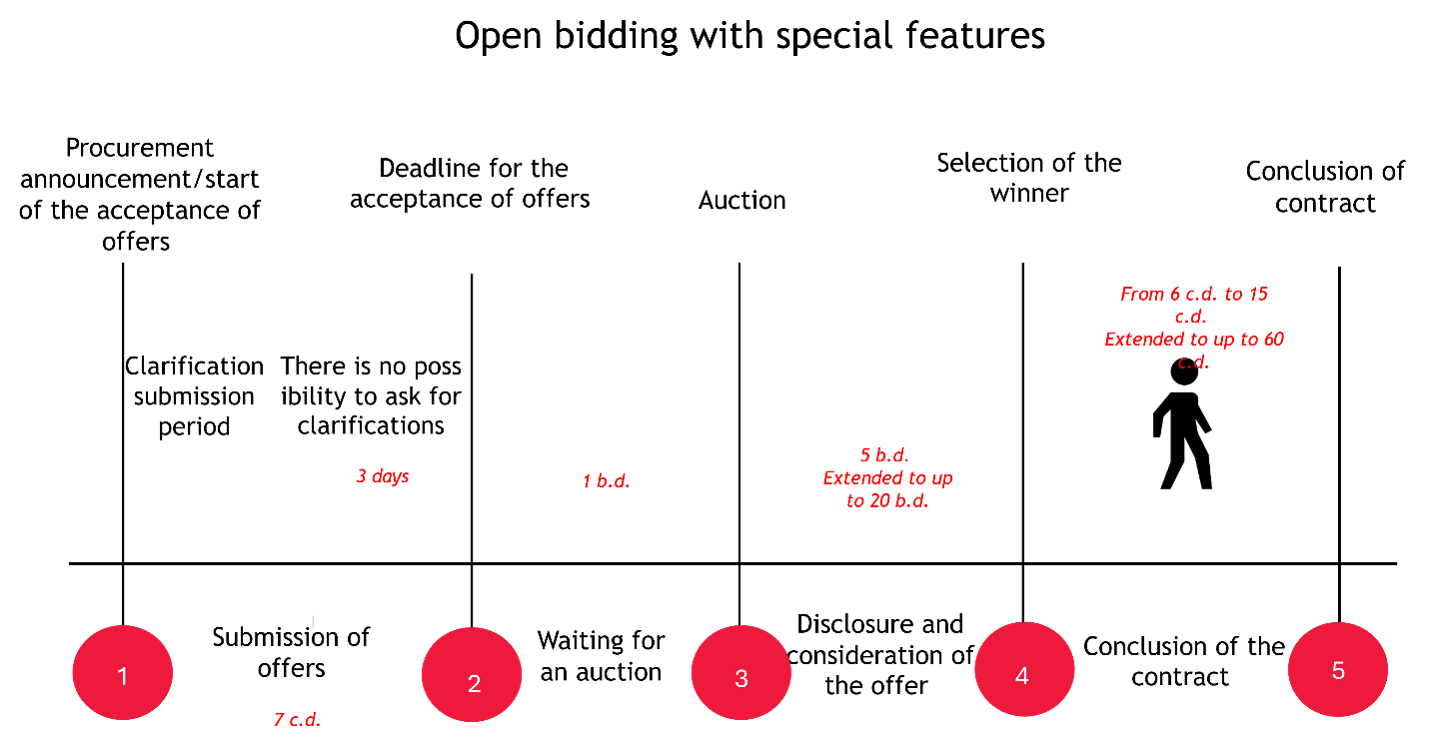
STAGE 1 Announcement of procurement/acceptance of proposals:
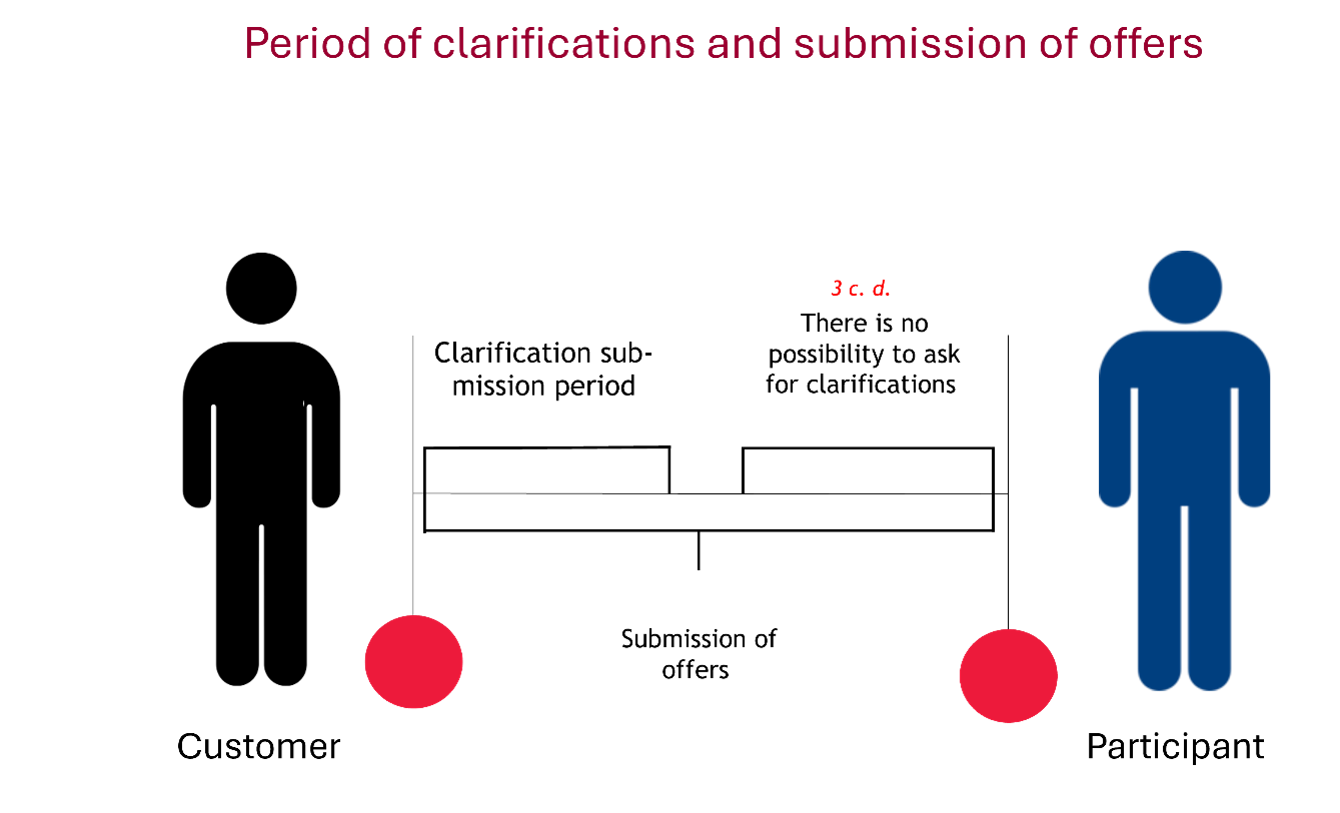
The procurement announcement shall be made in accordance with the form approved by Article 10 of the Law on Public Procurement | dated 25.12.2015 No. 922-VIII (rada.gov.ua). The tender organizer announces the procurement through one electronic platform, but within a few minutes this information appears on all electronic platforms.
The period of clarifications and submission of proposals takes place immediately after the publication of the announcement of the procurement. This period lasts at least 7 calendar days. This means that during this time, the bidders interested in this tender can contact the tender organizer for clarification, as well as submit their proposals.
Starting from the first day and during the entire period of submission of the proposals, tender organizers may make changes to the procurement announcement and tender documentation, and the bidders may submit their proposals and contact the organizers with questions/requirements/complaints, but no later than 3 c.d. before the deadline for submission of proposals, specified in the announcement. The tender organizer, in turn, is obliged to provide the answers to these questions within 3 business days from the date of receipt of the question.
The tender organizer may amend the published tender at any time, provided that potential bidders have at least 4 days before the deadline for submission of the proposals. In the event that the tender organizer has made changes to the documentation later than 4 days in advance, then the submission deadline shall be extended in such a way that at least 4 calendar days are left until the deadline for accepting the proposals. At the end of the submission of the bids, the system automatically determines the date and time of the auction, usually on the next business day after the deadline for accepting the bids.
The tender organizer may amend the published tender at any time, provided that potential bidders have at least 4 days before the deadline for submission of the proposals. In the event that the tender organizer has made changes to the documentation later than 4 days in advance, then the submission deadline shall be extended in such a way that at least 4 calendar days are left until the deadline for accepting the proposals. At the end of the submission of the bids, the system automatically determines the date and time of the auction, usually on the next business day after the deadline for accepting the bids.
If only one bidder submits a tender offer during an open bidding with features, then the open bidding will take place without the use of an auction, and the tender organizer will be able to consider a single tender offer for compliance with the requirements.
STAGE 2: Auction
The system activates the “Auction” module if several bidders (i.e. more than one) have submitted their bids. Prior to the start of the auction, the number of the submitted bids is not disclosed.
The auction takes place in three rounds, during each of which the participants have two minutes to reduce their bids in real time. The bidder with the lowest price has the opportunity to lower their price last. The participant can reduce the price in any round or in none.
At the end of the third round, the auction result is announced on the auction page: information about the names of the companies participating in the auction and information about the bid prices provided by the Bidders in each of the rounds are published.
STAGE 3: Consideration of the proposals and selection of the winner
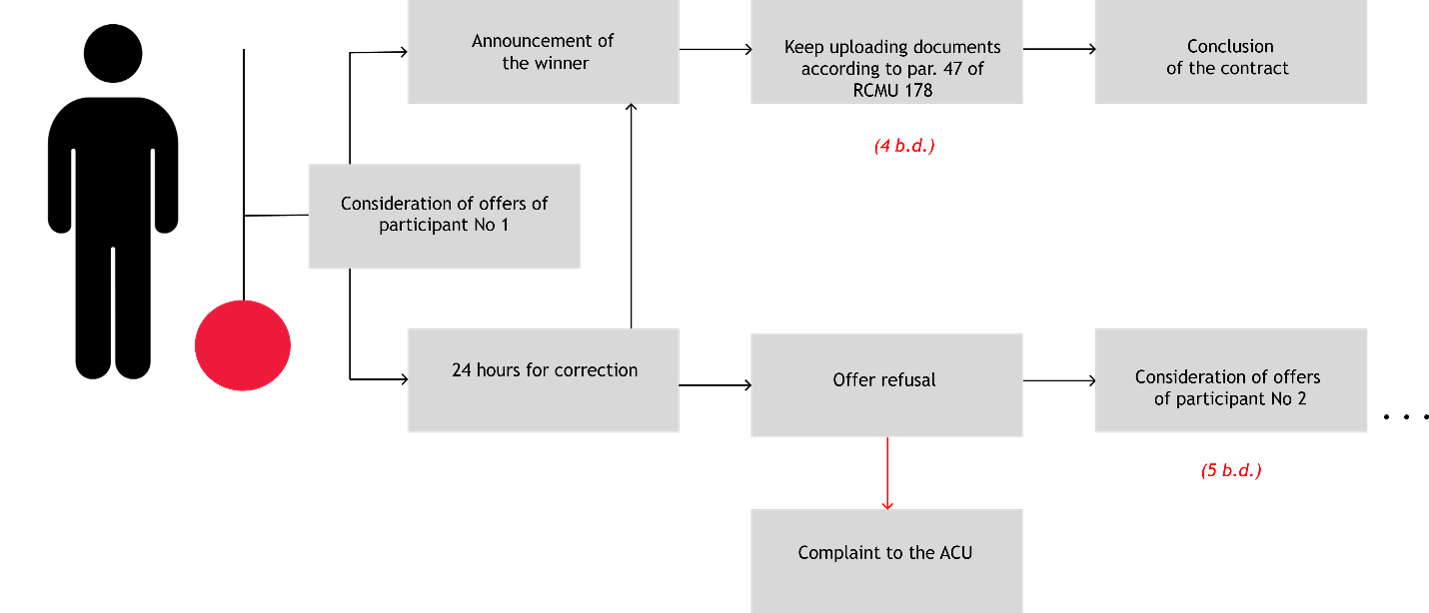
STAGE 4: Selection of the winner
After the tender organizer has accepted the most cost-effective offer (decided on the winner of the tender), the winner must provide own original documents within 4 days. The list of these documents is determined by Law No. 922-VIII. The documents that need to be provided are those that confirm the absence of the grounds, specified in paragraphs 3, 5, 6, 12 of part one and part two of Article 17 of the Law. At the same time, the Customer does not require confirmation if the information is available in the open registers or in the form of open data.
The tender organizer and the winner of the procurement have a maximum of 15 calendar days to conclude the contract. This period may be extended up to 60 calendar days if the tender organizer justifies such changes.
5. Simplified procurement
The second type of procurement is Simplified procurement. Tender organizers apply this procedure under the following price conditions:
Simplified procurement
The second type of procurement is Simplified procurement. Tender organizers apply this procedure under the following price conditions:
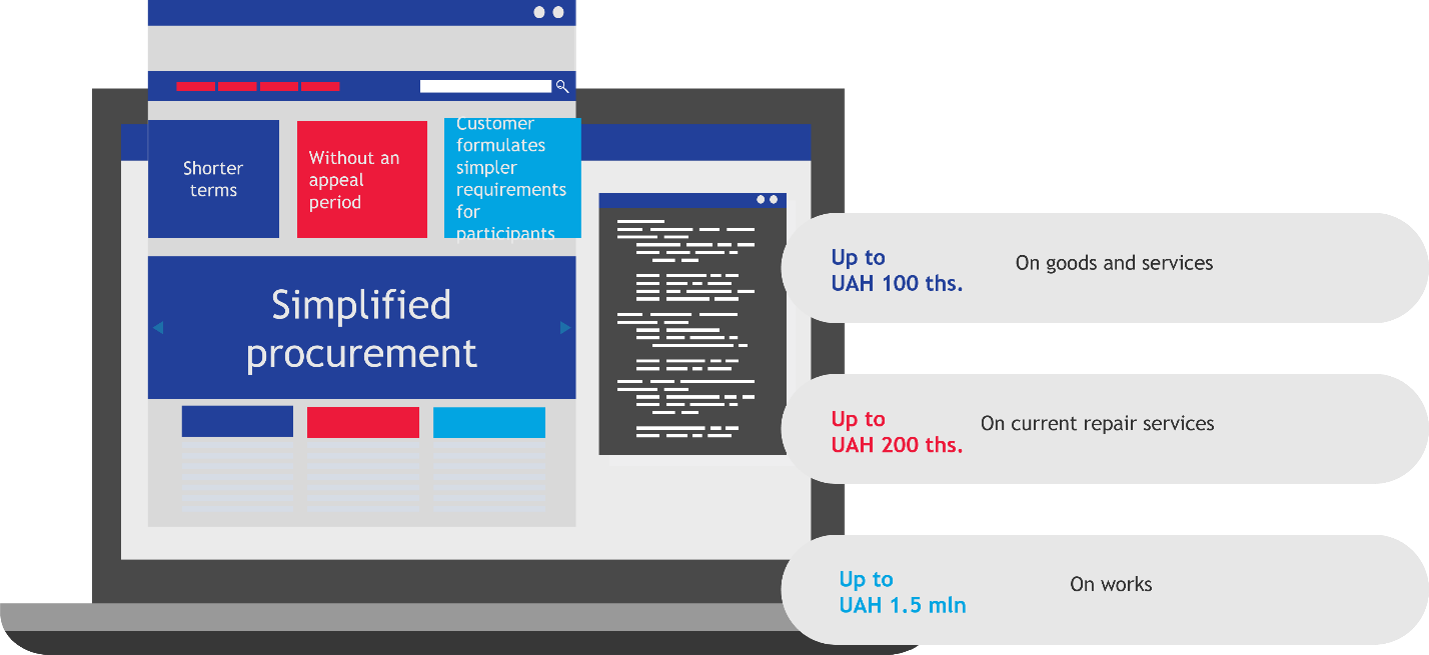
The second type of procurement is Simplified procurement. Tender organizers apply this procedure under the following price conditions:
This procurement is carried out in a more simplified way, namely in a shorter time, with a minimum package of documents and without a period for appealing the requirements.
This procurement procedure involves the following stages:
- Tender announcement
- Clarification period
- Submission of proposals
- Auction
- Review and evaluation of the proposals
- Conclusion of the contract
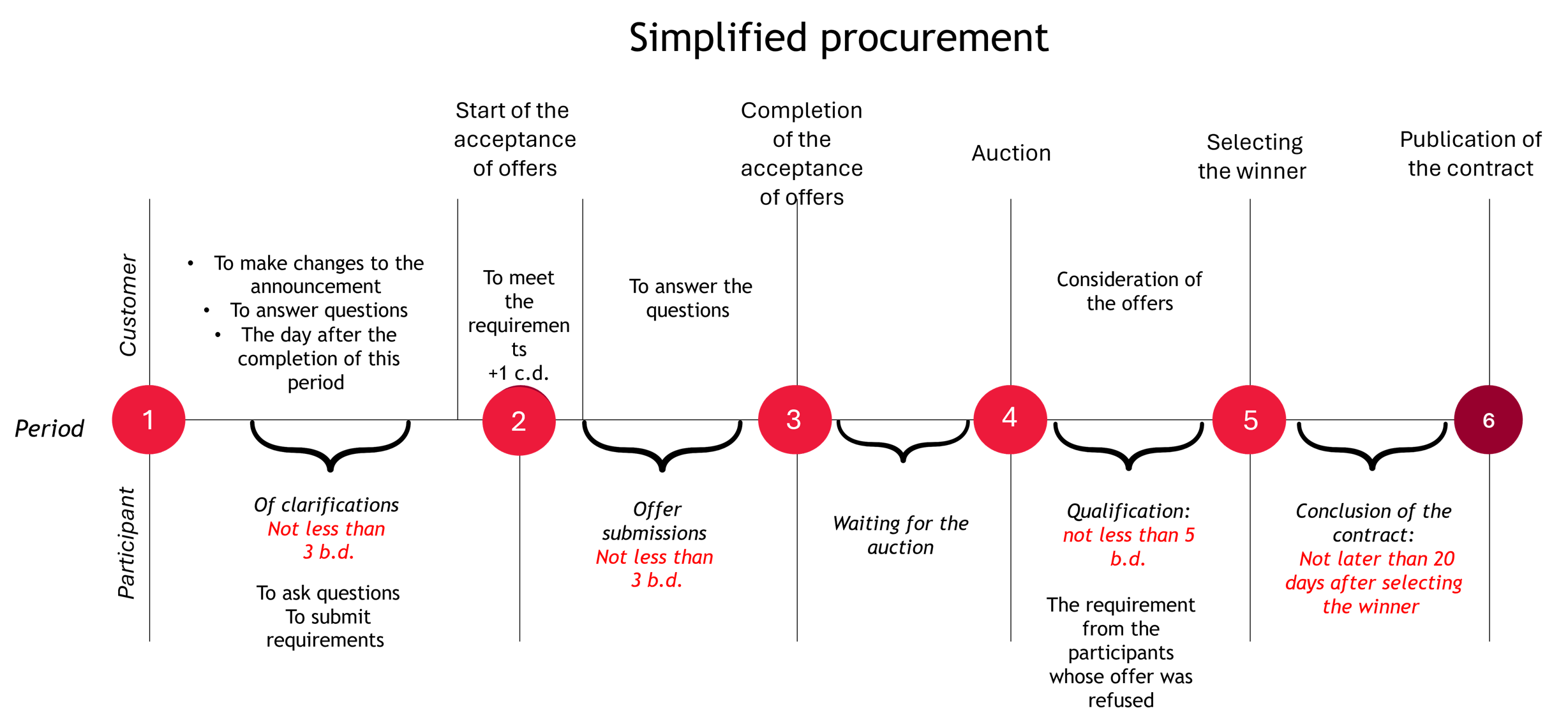
Clarification period: in this procurement lasts at least 3 business days. At this time, the bidder has the opportunity to contact the tender organizer through the platform for clarification on the information specified in the procurement announcement.
The tender organizer is obliged to provide clarifications and/or make changes to the announcement within 1 business day after the application.
Submission of the proposals: cannot be less than 2 business days.
Auction: is not mandatory. It is held only if at least two participants have sent their proposals. According to the results of three rounds of price reduction, the participant with the most favorable offer wins.
If only one proposal is submitted for the tender, the procurement immediately goes to the next stage.
Consideration and evaluation of the proposals. The deadline of consideration by the tender organizer of the bid of the winner of the auction for compliance with the terms of the tender documentation does not exceed 5 business days.
Conclusion of a procurement contract, if all documents of the most cost-effective offer meet all the requirements of the tender documentation, the Tender organizer signs a contract with the participant.
3. Registration and features of work on the authorized electronic platform
As it was previously noted, the bidders submit their tender proposals through authorized electronic platforms (AEP). The list of AEP is available at the link Home | Prozorro.
Currently, 12 electronic platforms are accredited in the Prozorro system. All the platforms have the same functionality for bidding, but differ in interface and additional options. Here is a list of these platforms:
| Platform Name | Link |
 | Public Bid |
 | SmartTender.biz |
 | Newtend |
 | E-tender |
 | Zakupivli.Pro |
 | Public Procurements.Online |
 | zakupki.com.ua |
 | Ukrainian Universal Exchange |
 | TENDER - online |
 | GOV. AUCTION |
 | IZI. TRADE |
 | “PlayTender” |
The following platforms have the ability to choose an interface in a foreign language and are equipped with an additional feedback function for communicating with English-speaking consultants.
| Platform Name | Link to registration instructions |
“SMARTTENDER” LLC | |
“E-Tender” LLC |
Peculiarities of registration for non-residents
The registration procedure for all platforms is mostly identical. To do this, on the main page of the platform you have chosen, you need to follow the “Registration” link and fill in the fields. During registration, there is a mandatory procedure for identifying the participant.
Identification of the registered participant is carried out in one of the following ways:
- A symbolic payment of UAH 20 is made from the company's current account;
- signing a contract using an EDS. You will receive an e-mail with a link to the completed contract, apply an EDS and send it to the AEP.
- signing a contract in paper form.
Identification is required for AEP to make sure that the company is really established and aims to participate in the tenders.
How can a non-resident company replenish the balance of the cabinet?
For companies that are non-residents of Ukraine, there are certain features here.
After registration, the contact person of the non-resident company will be contacted by the platform manager to sign the contract. The contract is signed bilingually (ukr / eng, ukr / rus).
Based on the details specified in the contract, an account is formed in euros or US dollars. The company pays the required amount in a currency convenient for it (USD or EUR). However, this must be done from the current account of the non-resident participant's company.
After receiving payment in foreign currency, the funds are converted into hryvnias to the participant's personal cabinet at the NBU exchange rate at the time of their receipt. And after that, the company can participate in procurement.
To log in to the account, use a username and password. Login is the participant's email address, password is a combination of characters that is generated during registration.
There is a fee for participation in the Prozorro procurement. The amount of payment for participation in the tenders depends on the procurement budget, approved by the resolution of the Cabinet of Ministers of Ukraine, and on all electronic platforms it is the same and is:
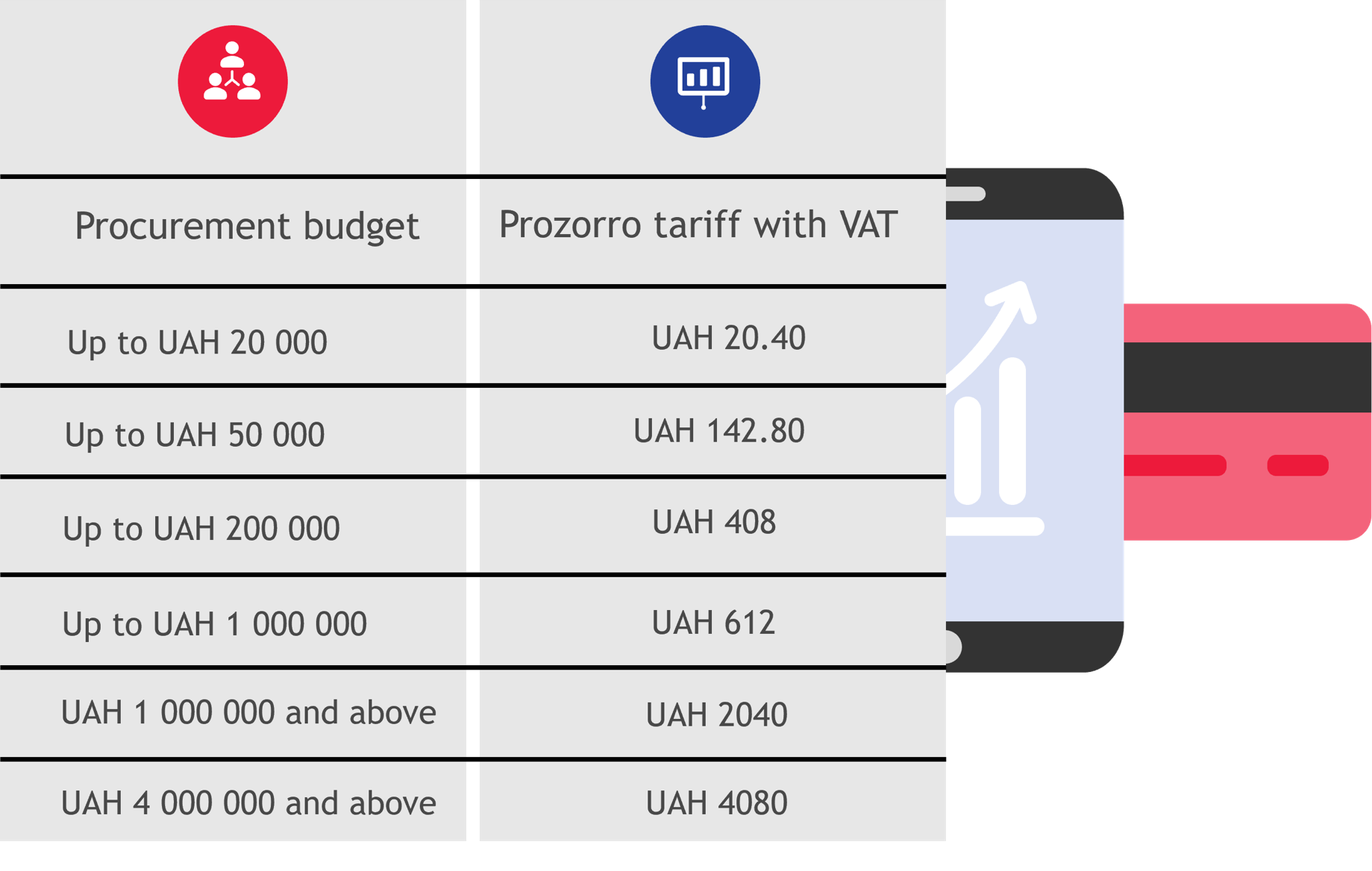
participation in the Prozorro procurementTo participate in the procurement procedure, the bidder’s balance sheet must contain an amount corresponding to the cost of participation in the procurement. Funds are debited automatically when sending an offer, so if the required amount is not on the balance, the participant will not be able to submit his offer.
For the non-residents of Ukraine, the period for crediting funds to the balance may be longer than for the residents, and may take up to 5 business days. This is due to additional checks carried out by the banks for the non-residents. Therefore, when planning participation in the procurement, it is advisable to consider the following tips:
- Replenish your balance in advance to ensure that the funds are received before the deadline for submitting an offer;
- Contact AEP support if the funds have not been credited to your balance within 5 business days.
For the residents of Ukraine, funds are usually credited to the balance within a few hours.
In your electronic account on AEP, you can set up electronic mailing of tender announcements. Thus, you will receive tender announcements every day that correspond to your CPV code (code of goods, works and services you are interested in). The CPV code is determined according to DK 021:2015.
However, it is possible to subscribe to the tenders according to other parameters, for example:
By the subject of procurement:
- Enter keywords in the “Tender name” field.
- Select the CPV code from the drop-down list.
By date:
- Enter the date of publication of the announcement.
- Select the tender status (active, completed).
By customer:
- Enter the name or EDRPOU of the tender organizer.
By location:
- Select a region or city.
At the expected cost:
- Specify the range of expected value.
On the websites of electronic platforms, you can find detailed instructions for registration, replenishment of the balance, submission of the offers, subscription to newsletters and others.
If interested in participating in the tenders, it is proposed to act according to the following plan:
- Find a procurement announcement
- Check compliance with the established requirements
- Clarify all issues that arise during the preparation of the proposal with the organizers of the tenders within the established deadlines
- Prepare a tender proposal
- Check the availability of the required amount on the AEP balance
- Submit your proposal
- Take part in an electronic auction on the day of the auction
- In case of acceptance of your offer, upload the winner's documents to the platform
- Sign the contract with the tender organizer within the established deadline.
Remember that the tender process requires patience and persistence. Do not give up after the first failures, because each tender is a valuable experience that leads you to victory.